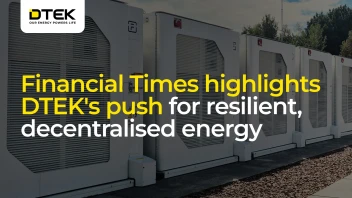Philipp Leckebusch – Chief Technology Officer, DTEK. The column was published on Interfax.com.ua
The global energy system is undergoing an unprecedented transition shifting from fossil fuels to renewables such as wind, solar energy, biomass, and hydrogen. The change is driven by cutting-edge technologies opening new opportunities for both governments and businesses.
Decarbonization has become a new global trend, resulting in Europe’s Green Deal. It aims to build a carbon-neutral economy in the EU by 2050 while ensuring the sustainable development of all fields.
Due to the EU’s strong desire to accelerate the energy transition, the Green Deal has become a European integration issue for Ukraine. The active position of Europe, facing a double challenge of climate change and post-COVID economic recovery, prompts both the Ukrainian government and the private sector to prepare for the necessary changes in the energy sector. Ensuring the flexibility and resilience of the domestic energy system is the top priority.
The launch of the Ukrainian energy system in synchronization mode with the European energy system ENTSO-E is planned for the third quarter of 2023. In 2022, the Ukrainian energy system will be tested in isolated mode. Before separating from the Russian energy system, Ukraine must ensure sufficient balancing and reserve capacities to prove that supplies are possible under all circumstances.
Integrating the Ukrainian energy system with the European one is an important element of Ukraine's energy security. The synchronization will improve the reliability and resilience of the Ukrainian energy system, expand the opportunities for exchanging electricity between countries, increase competition in the domestic market, and enable to work in the European energy market. But the Ukrainian energy system must become self-sufficient to achieve this.
In addition, the European Carbon Border Adjustment Mechanism (CBAM) will align import carbon prices and the industrial carbon prices within the EU Emissions Trading System. The CBAM will be proposed on July 14 and is expected to launch in 2023, also encompassing electricity supplies.
The EU Climate Law, officially adopted in late June, is soon to be published and enter into force. It requires reducing emissions 55% by 2030, accelerating the transition of the energy system to renewable and low-carbon sources.
In this regard, to integrate Ukraine into the EU, the largest market on our continent, timely regulatory and technical adjustments are required, to ensure a free flow of electricity between Ukraine and the EU in the future. It will, in turn, help realize Ukraine's potential for regional leadership in decarbonization and greatly contribute to the achievement of the European Union's carbon neutrality goals.
Mindful of all these challenges, DTEK recently launched the first Ukrainian industrial lithium-ion energy storage system (ESS) with 1 MW capacity and 2.25 MWh storage. The ESS was installed at the Zaporizka TPP in Enerhodar and can accumulate, store, and deliver electricity to grids, as well as provide services to ensure resilience and flexibility of the Ukrainian energy system. This is DTEK's pilot project to find optimal ESS operation models for various segments of the country's energy market.
In addition, the company recently launched tests to improve electricity generation projections for its solar and wind power plants. It is an important step to fully integrate renewables into the market by the end of next year. Close cooperation and real-time data exchange between RES (renewable energy sources) and the system operator will help radically minimize potential decreases in green energy use.
To this end, the Ukrainian ancillary services market must constantly develop to quickly and efficiently provide the required frequency maintenance reserve. In addition, investments in grid infrastructure and digitalization are now important to ensure efficient data management for the necessary flexibility.
Gradually ceasing coal generation, Ukraine must decide on a regulatory framework for new reserve capacity requirements, likely to include natural gas and options for a subsequent transition to hydrogen.
With rapidly growing but unstable solar and wind energy generation, there is a pressing need to increase the energy system’s flexibility. In Ukraine, the optimal way to balance the energy system and avoid the RES limitations is to increase the flexibility of the energy system by attracting investments in the construction of highly adaptable generation and energy storage systems as soon as possible.
By implementing all available options for energy system flexibility, we will be able to complete this transition in the most efficient way and ensure the resilience of the Ukrainian energy system in a growing, dynamic environment.







